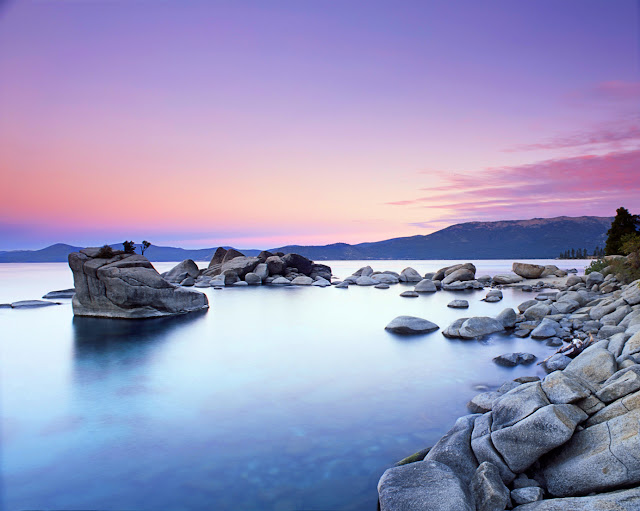Postcards from my Photo Lab
I am fortunate to have amazing photo opportunities close to home. Bonzai Rock and Sand Harbor State Park are particularly convenient and gorgeous. This photogenic location (I hope you like it, because I go here often) is only about a 20 mile, or 30 minute, drive from my house. It's nice because I can experiment and learn - using multiple trips to see how different combinations of tools, technique, and serendipity affect the final image. These two pictures, for example, while at first appearance my appear very different, they are, in fact, quite similar. Varying only in the film used and the exact spot I stood. Both were taken on relatively calm clear mornings with the same subject and basic compositional elements. I've taken a number of predawn trips up to the lake to this same location and used it as kind of a photo "lab". Not the kind of photo lab where you drop off film and then pick up prints an hour later. In this context, I mean "lab" as in "a place where experiments happen". Each time I go up, I try to keep things simple and only change one thing and I like going at the predawn hour because it keeps things much simpler in terms of equipment and technique. Normally, shooting a landscape that includes a sky requires a graduated neutral density filter to narrow the tonal range of the scene, but I have learned that at dawn there is a sweet spot 10-20 minutes before the sun rises where the light is very even and lovely. Normally everything will fall into a range of 4-5 stops. I've also learned that Fuji Velvia records the light at this time in rich violets, pinks, and tangerine and can record about 4-4.5 stops of light. With a standard exposure, I should have a full tonal range on my negative, even though to the human eye, it seams like the scene is low contrast and kind of dull.
But what really matters, I suppose, is how it looks once its on paper. I've printed the color photo large (16x20) cheaply at Costco and it looks great. I wonder what kind of difference it would make having it done by a professional fine art printer. I've had experienced photographers tell me the B&W negative has the ability to produce a world class print, if printed by the right person. I can tell you... I am not that person, and neither is Costco. Unfortanely, there isn't any optical printers in Reno, so I would have to send my negative to San Francisco or San Diego and fork out some serious dough. I guess I will have to add this to the growing pile of future photography endeavors.
 |
| Coral Skies Electric Water. Sand Harbor State Park, NV. Mamiya RB67 ProSD, Mamiya-Sekor 50mm 4.5 C. Fuji Velvia 50. Processed at Nicoll's in SLC, UT. Scanned Epson 500. |
The second picture is the the same subject and similar conditions with the same camera and lens. The only difference is the film, in this case Kodak 400TX black and white film. It's funny, I didn't know there was a difference between 400TX and 400TMAX until I looked up information on how to process the films and then saw they do not have the same recommended development. Hmmmm. I asked the local shop owner about this and he said that TMAX is modern technology and TX is old technology, and people may clamour on about the special qualities of the old film, but the modern film is just plain better. Hmmmmm. He also mentioned that he knows the secret to getting the greatest negatives out of TMAX film and that if I follow Kodak's recommendations, I selling my photography short. Hmmmmmm. How does this shop owner in Carson City know what Kodak doesn't?
Anyway, back to my black and white treatment. Again, well before sunrise with no filters. The water was actually much calmer in this picture than the color, but since I was using a 400 speed film with little reciprocity, my exposure was along the lines of seconds instead of minutes. This picture is also very strong. In fact, I believe it is a better composition than the first. The photo rest solely on the tones and my choice of subject placement within it's environment. The color photo, while compositionally adequate, gets its impact from the surreal colors rendered by the Fuji film.
 |
| Bonsai Rock Solitude. Sand Harbor State Park, NV. Mamiya RB67 ProSD, Mamiya-Sekor 50mm 4.5 C. Fuji Velvia 50. Processed at home with D76 for 12min at 21 degrees. Scanned Epson 500. |
Chris



Comments
Post a Comment